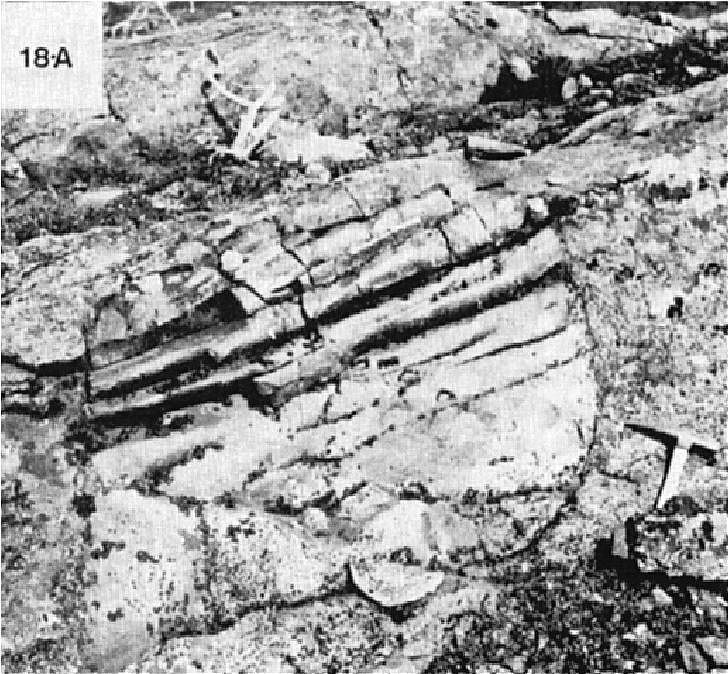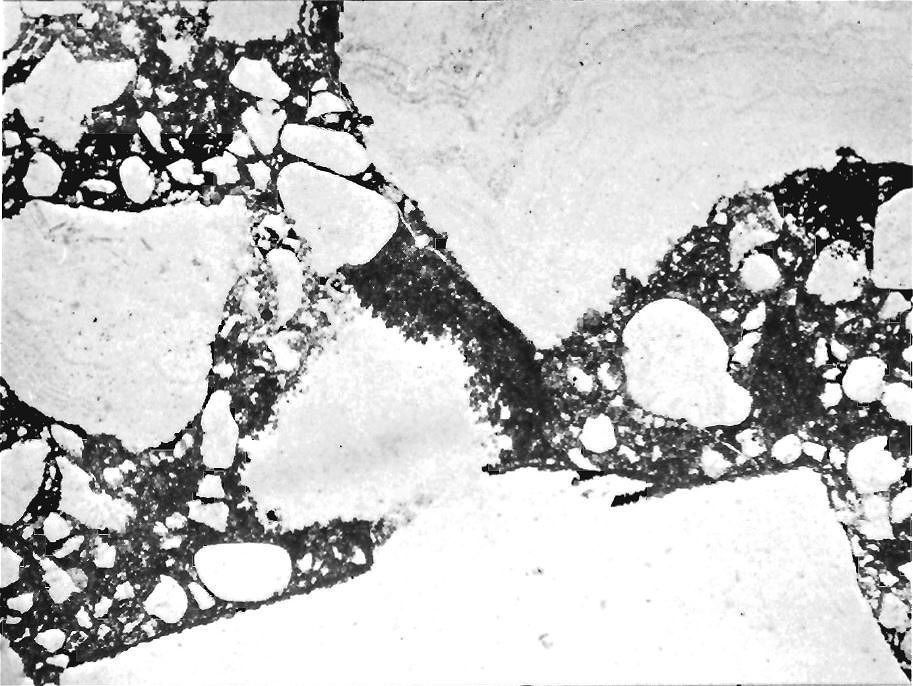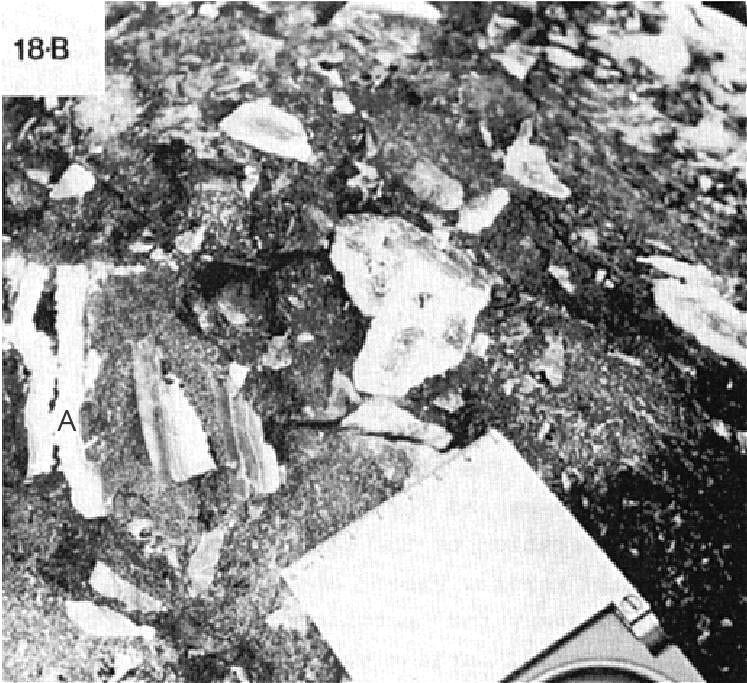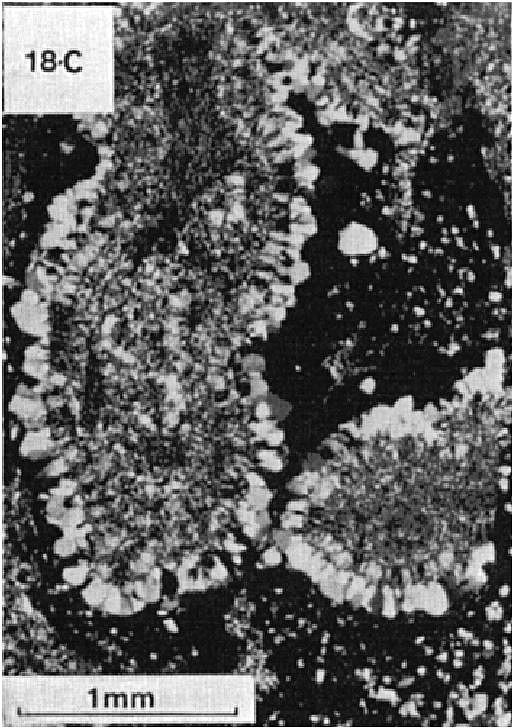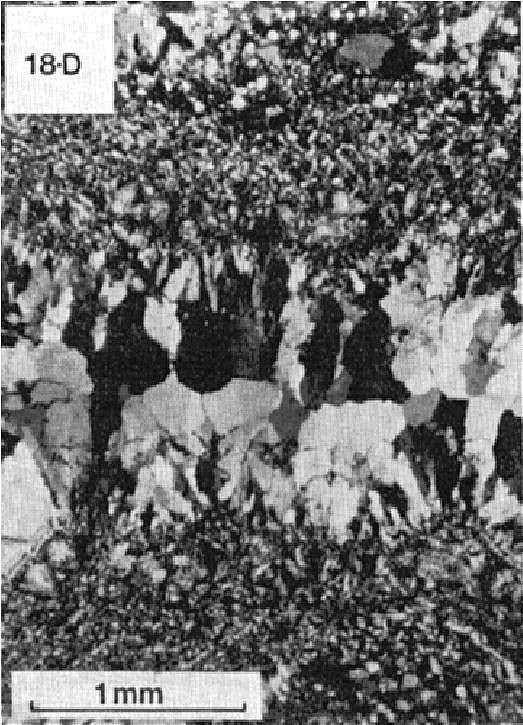
DISCLAIMER: This English version is translated from the original French. In case of any discrepancy, the French version shall prevail.
| Author(s): | Harrison, 1952 |
| Age: | Paleoproterozoic |
| Stratotype: | None |
| Type area: | Burnt Creek area, west of Schefferville (NTS sheet 23J15) |
| Geological province: | Churchill Province |
| Geological subdivision: | New Quebec Orogen (Labrador Trough) / Schefferville Lithotectonic Zone |
| Lithology: | Chert breccia, siltstone, mudstone, sandstone |
| Category: | Lithostratigraphic |
| Rank: | Formation |
| Status: | Formal |
| Use: | Active |
Background
Geologists from Labrador Mining and Exploration (1949, see Frarey and Duffell, 1964) called a cherty breccia unit located in the Schefferville area the « Fleming chert breccia ». These authors placed this unit stratigraphically above the Denault dolomite and below the Wishart quartzite (see Frarey and Duffell, 1964). The name Fleming Formation was formalized by Harrison (1952) in his description of the geology of a NE-SW oriented strip at Schefferville (« Burnt Creek strip« ). It should be noted that the name Fleming does not refer to a particular geographical entity, but its use is well established in the literature and justifies its retention. Baragar (1967) subsequently described this unit between Helluva Lake and Le Fer Lake, but did not distinguish it on his map. Dimroth (1978) mapped the Fleming Formation from the Helluva and Le Fer lakes area to Knob Lake, south of Schefferville. He also included the Fleming Formation in the Attikamagen Subgroup, later reclassified as the Attikamagen Group by Clark and Wares (2004).
The Fleming Formation has been extensively described by several authors (Dufresne, 1952; Howell, 1954; Baragar, 1967; Gross, 1968; Dimroth, 1971; Birkett, 1991). It has also been the subject of geological reconnaissance work in the Schefferville area (Clark et al., 2008).
Description
The Fleming Formation is a sedimentary unit belonging to the upper part of the Attikamagen Group. It represents the western equivalent of the Dolly Formation. It consists essentially of chert breccia containing milky white chert fragments hosted in a siltstone or sandstone matrix. The different lithologies that make up the formation are presented in Table 1.The colour of the rocks varies from milky white to grey, pink, brown, red or green (Harrison, 1952; Harrison et al., 1972). Chert breccia, which forms over 90% of the formation, is a homogeneous rock with little structure. However, there is evidence of stratification locally (Dimroth, 1971, 1978; Zajac, 1974).
The base of the Fleming Formation generally comprises a 0.6 m to 3 m thick greenish grey argillaceous siltstone layer (Baragar, 1967; Dimroth, 1971, 1972, 1978). The latter is massive, locally laminated, and commonly contains chert lenses and veinlets. Argillaceous siltstone is overlain by chert breccia arbitrarily divided into two or three randomly interdigitating zones. The lower part of the Fleming Formation generally contains fragments of irregularly contorted laminated chert, laminated brecciated chert, chert breccia and siltstone in an argillaceous siltstone matrix. In the Le Fer Lake area, this part consists locally of massive or residual light grey chert probably derived from the replacement of laminated or intraclastic dolomite (Dimroth, 1971). The upper part of the formation comprises fragments of chert breccia, sandstone and cemented chert breccia in a medium to coarse-grained sandstone matrix. Siltstone is generally absent. At the top, the rocks locally possess dolomitic cement (Dimroth, 1971, 1972, 1978). Based on observations by Clark et al. (2008), the Fleming Formation contains in its upper part lenses and layers of quartzitic sandstone similar to that of the Wishart Formation.
Table 1: Characteristics of Fleming Formation Lithologies (Dimroth, 1971, 1978)
| ARENITES | |||||||||||||
|---|---|---|---|---|---|---|---|---|---|---|---|---|---|
| Argillaceous Siltstone | |||||||||||||
| Dark greenish grey in fresh and altered surfaces; angular to subangular quartz grains ~0.05 mm in diameter; argillaceous matrix (30-70%); siliceous cement; abundant apatite | |||||||||||||
| Coarse-Grained Sandstone | |||||||||||||
| Light grey in fresh and altered surfaces; well-rounded quartz grains ~0.5 to 1 mm in diameter; siliceous cement | |||||||||||||
| CHERT | |||||||||||||
| Massive Replacement Chert | |||||||||||||
| Light grey, homogeneous; local occurrence (near Le Fer Lake) | |||||||||||||
| Replacement Chert with Residual Structure | |||||||||||||
| Light grey chert with the residual structure of intraclastic dolomite; local occurrence (near Le Fer Lake) | |||||||||||||
| Laminated Chert | |||||||||||||
| Dark grey to black chert laminae (3-10 mm thick) alternating with argillaceous siltstone laminae (5-20 mm thick) | |||||||||||||
| BRECCIA | |||||||||||||
| Laminated Brecciated Chert | |||||||||||||
| Fragments of laminated chert hosted in argillaceous siltstone | |||||||||||||
| Chert Breccia with Siltstone Matrix | |||||||||||||
| Chert fragments (described below) hosted in an argillaceous siltstone matrix | |||||||||||||
| Chert Breccia with Sandstone Matrix | |||||||||||||
| Chert fragments (described below) hosted in a coarse-grained sandstone matrix | |||||||||||||
| Cemented Chert Breccia | |||||||||||||
| Chert fragments cemented with chert; strongly recrystallized, almost homogeneous varieties | |||||||||||||
| CHERT FRAGMENTS | |||||||||||||
| Homogeneous Chert | |||||||||||||
| Angular fragments of milky white, homogeneous chert | |||||||||||||
| Chalcedony Nodules and Amygdule Coating | |||||||||||||
| Fragments of laminated chalcedony nodules and fragments of partially filled cavities |
Fragments consist of massive, homogeneous microcrystalline chert, banded chert or quartz. Blocks of sandstone or quartz arenite (<30 cm) locally containing chert pebbles are also observed (Clark et al., 2008). Some of these blocks display relics of stratification with beds 5-10 cm thick (Dimroth, 1971 and 1978). Chert fragments are grey to milky white and range in size from pebbles to blocks (1-60 cm). Most are angular, but some are rounded (Dimroth, 1971; Zajac, 1974; Clark et al., 2008). Tabular fragments are observed in places (Baragar, 1967; Dimroth, 1971). Many chert clasts are derived from chalcedony cavity filling. Fragments from veinlet filling are also common (Dimroth, 1971, 1972, 1978). The rocks of the Fleming Formation are slightly metamorphosed to the greenschist facies (Fraser et al., 1978).
Rocks of the Fleming Formation were deposited at the bottom of a slope bordering a basin near the western margin of the Labrador Trough (Dimroth, 1971, 1978; Wardle and Bailey, 1981). The origin of chert breccia has been studied by several authors (Harrison, 1952; Dufresne, 1952; Howell, 1954; Baragar, 1967; Gross, 1968; Dimroth, 1971). According to Dimroth (1978), the Fleming Formation is derived from a stratified sequence of sandstone, siltstone, dolomite and gypsum, which was silicified and brecciated. Brecciation is thought to be the result of collapse by dissolution of evaporites and sliding. Birkett (1991) interprets chert breccia as a siliceous sediment formed in shallow water and associated with evaporites. This sediment would have undergone desiccation and synsedimentary slip (Clark et al., 2008).
Thickness and Distribution
The Fleming Formation belongs to the allochthonous Schefferville Lithotectonic Zone, as defined by Clark and Wares (2004). It is only recognized near the western margin of the Labrador Trough, south of latitude 55°30′N. It extends from the Helluva and Le Fer lakes area (sheet 23O06) to Schefferville (sheet 23J15), a distance of ~80 km (Dimroth, 1971, 1972, 1978). On the Labrador side, Fleming rocks have been followed SE to Marble Lake (sheet 23J08) (Evans, 1978; Wardle, 1979, 1982), an additional ~45 km. Fleming-like rocks have also been observed above the Denault Formation dolomite in the Marion Lake area (Harrison, 1952; Donaldson, 1966).
Near the western margin of the Labrador Trough, the Fleming Formation is ~15 m thick. It thickens eastward and reaches ~100 m in the Schefferville area, then gradually thins eastward (Harrison, 1952; Harrison et al., 1972; Gross, 1968; Dimroth et al., 1970; Wardle, 1979). According to Dufresne (1952, in Baragar, 1967) and Zajac (1974), the thickness of the central part of the formation varies from 100 to >120 m in the Schefferville area. Evans (1978) estimated the thickness to be ~130 m in the Dyke Lake area (sheet 23J10), SE of Schefferville.
Dating
None.
Stratigraphic Relationship(s)
The rocks of the Fleming Formation were deposited towards the end of the first volcano-sedimentary cycle of the Labrador Trough, around 2142 +4/-2 Ma (T. Krogh and B. Dressler, unpublished data cited in Clark, 1984, page 4). However, they may be much younger as they were deposited towards the end of the sedimentation period of the Attikamagen Group, estimated to be between 2.06 Ga and 1878-1880 Ma (Chevé and Machado, 1988; Findlay et al., 1995; Melezhik et al., 1997). According to the interpretation of Wardle and Bailey (1981), the Fleming Formation is slightly younger than the Dolly Formation.
The Fleming Formation occupies a stratigraphic position equivalent to that of the Dolly Formation at the top of the Attikamagen Group Group near the western margin of the Labrador Trough (Wardle and Bailey, 1981). According to Dimroth et al. (1970), the two formations appears to interdigitate eastward. The Fleming Formation is overlying the Denault Formation and underlying the Wishart Formation (Ferriman Group) (Harrison, 1952; Harrison et al., 1972; Dimroth et al., 1970; Dimroth, 1971, 1972, 1978). Its base is in conformable contact with the underlying Denault Formation (Dimroth, 1971, 1972, 1978; Wardle, 1979). In places, the Fleming Formation is absent and the Wishart Formation lies directly on the Denault Formation (Harrison, 1952; Baragar, 1967; Harrison et al., 1972). According to Dimroth (1972, 1978), the Fleming Formation is overlain in low angle erosional unconformity by the Wishart Formation. Clark et al. (2008), in their work in the Schefferville area, found that there appears to be a transition between the chemical-detritic sedimentation of the Fleming Formation and the essentially detritic sedimentation of the Wishart Formation. In places, Dimroth (1971) mentions a sharp contact between the two formations.
Paleontology
Does not apply.
References
Publications Available Through SIGÉOM Examine
CLARK, T. 1984. GEOLOGIE DE LA REGION DU LAC CAMBRIEN – TERRITOIRE DU NOUVEAU-QUEBEC. MRN. ET 83-02, 77 pages and 1 plan.
CLARK, T., LECLAIR, A., PUFAHL, P., DAVID, J. 2008. RECHERCHE GEOLOGIQUE ET METALLOGENIQUE DANS LES REGIONS DE SCHEFFERVILLE (23J15) ET DU LAC ZENI (23I16). COMMISSION GEOLOGIQUE DU CAN, UNIVERSITE ACADIA, MRNF, GEOTOP QAM-MCGILL. RP 2008-01, 17 pages.
CLARK, T., WARES, R. 2004. SYNTHESE LITHOTECTONIQUE ET METALLOGENIQUE DE L’OROGENE DU NOUVEAU-QUEBEC (FOSSE DU LABRADOR). MRNFP. MM 2004-01, 182 pages and 1 plan.
DIMROTH, E. 1972. STRATIGRAPHY OF PART OF THE CENTRAL LABRADOR TROUGH. MRN. DP 154DP 154, 304 pages and 6 plans.
DIMROTH, E. 1978. REGION DE LA FOSSE DU LABRADOR ENTRE LES LATITUDES 54° 30′ ET 56° 30′. MRN. RG 193, 417 pages and 16 plans.
Other Publications
BARAGAR, W.R.A. 1967. Wakuach Lake map-area, Quebec-Labrador (23O). Geological Survey of Canada; Memoir 344, 174 pages. https://doi.org/10.4095/123960
BIRKETT, T.C. 1991. Origin of the Lower Proterozoic Fleming chert-breccia, Newfoundland, Labrador-Québec. Geological Survey of Canada; Map 91-12, 44 pages. https://doi.org/10.4095/132666
CHEVÉ, S.R., MACHADO, N. 1988. Reinvestigation of the Castignon Lake carbonatite complex, Labrador Trough, New Québec. Joint Annual Meeting of the Geological Association of Canada and the Mineralogical Association of Canada, St. John’s, Newfoundland; Program with Abstracts, volume 13, pages 20.
DIMROTH, E. 1971. The Attikamagen-Ferriman transition in part of the central Labrador Trough. Canadian Journal of Earth Sciences; volume 8, pages 1432-1454. https://doi.org/10.1139/e71-132
DIMROTH, E., BARAGAR, W.R.A., BERGERON, R., JACKSON, GD. 1970. The filling of the Circum-Ungava geosyncline. In Symposium on Basins and Geosynclines of the Canadian Shield (A.J. Baer, editor). Geological Survey of Canada; Paper 70-40, pages 45-142. https://doi.org/10.4095/124922
DONALDSON, J.A. 1966. Marion Lake map-area, Quebec-Newfoundland (23I/13). Geological Survey of Canada; Memoir 338, 85 pages. https://doi.org/10.4095/123900
DUFRESNE, C., 1952. A study of the Kaniapiskau system in the Burnt Creek-Goodwood area, New Quebec and Labrador, Newfoundland. McGill University; Doctoral thesis.
EVANS, J.L., 1978. The geology and geochemistry of the Dyke Lake area (parts of 23J8, 9), Labrador. Newfoundland Department of Mines and Energy, Mineral Development Division; Report 78-4, 39 pages. https://gis.geosurv.gov.nl.ca/geofilePDFS/WBox040/023J_0058.pdf
FINDLAY, J.M., PARRISH, R.R., BIRKETT, T., WATANABE, D.H. 1995. U-Pb ages from the Nimish Formation and Montagnais glomeroporphyritic gabbro of the central New Québec Orogen, Canada. Canadian Journal of Earth Sciences; Volume 32, pages 1208-1220. https://doi.org/10.1139/e95-099
FRAREY, M.J., DUFFELL, S. 1964. Revised stratigraphic nomenclature for the central part of the Labrador Trough. Geological Survey of Canada; Paper 64-25, 13 pages. https://doi.org/10.4095/123909
FRASER, J.A., HEYWOOD, W.W., MAZURSKI, M.A., 1978. Carte métamorphique du Bouclier Canadien. Geological Survey of Canada; Map 1475A. doi.org/10.4095/133909
GROSS, G.A., 1968. Geology of Iron Deposits in Canada: Iron Ranges of the Labrador Geosyncline. Geological Survey of Canada; Economic Geology Report No. 22, volume III, 179 pages. doi.org/10.4095/123961
HARRISON, J.M. 1952. The Quebec-Labrador iron belt, Quebec and Newfoundland. Geological Survey of Canada; Paper 52-20, 21 pages. https://doi.org/10.4095/123923
HARRISON, J.M., HOWELL, J.E., FAHRIG, W.F. 1972. A geological cross-section of the Labrador miogeosyncline near Schefferville, Quebec. Geological Survey of Canada; Paper 70-37, 34 pages. https://doi.org/10.4095/102389
HOWELL, J.E., 1954. Silicification in the Knob Lake Group of the Labrador iron belt. University of Wisconsin; Doctoral thesis.
MELEZHIK, V.A., FALLICK, A.E., CLARK, T. 1997. Two billion year old isotopically heavy carbon: evidence from the Labrador Trough, Canada. Canadian Journal of Earth Sciences; volume 34, pages 271-285. https://doi.org/10.1139/e17-025
WARDLE, R.J. 1979.The western Margin of the Labrador Trough. Department of Mines and Energy, Government of Newfoundland and Labrador; Report 79-1, 7 pages. https://www.gov.nl.ca/nr/files/mines-geoscience-publications-reportactivities-1979-wardle2-roa1979.pdf
WARDLE, R.J. 1982. Geology of the south-central Labrador Trough. Government of Newfoundland and Labrador, Department of Mines and Energy, Mineral Development Division, Map 82-005. https://gis.geosurv.gov.nl.ca/geofilePDFS/ReceivedBatch58/LAB_0603.pdf
WARDLE, R.J., BAILEY, D.G. 1981. Early Proterozoic sequences in Labrador. In Proterozoic basins of Canada (F.H.A. Campbell, editor). Geological Survey of Canada; Paper 81-10, pages 331-359. https://doi.org/10.4095/124192
ZAJAC, I.S., 1979. The stratigraphy and mineralogy of the Sokoman formation in the Knob Lake area, Quebec and Labrador. Geological Survey of Canada; Bulletin 220, 159 pages. doi.org/10.4095/123946
Suggested Citation
Ministère de l’Énergie et des Ressources naturelles (MERN). Fleming Formation. Quebec Stratigraphic Lexicon. https://gq.mines.gouv.qc.ca/lexique-stratigraphique/province-de-churchill/formation-de-fleming_en [accessed on Day Month Year].
Contributors
|
First publication |
Charles St-Hilaire, GIT, M.Sc. charles.st-hilaire@mern.gouv.qc.ca; Thomas Clark, P. Geo., Ph.D. (redaction) Mehdi A. Guemache, P. Geo., Ph.D. (coordination); Claude Dion, Eng., M.Sc. (critical review); Simon Auclair, P. Geo., M.Sc. (editing); Céline Dupuis, P. Geo., Ph.D. (English version); André Tremblay (HTML editing). |



